Native Son – January, 2012
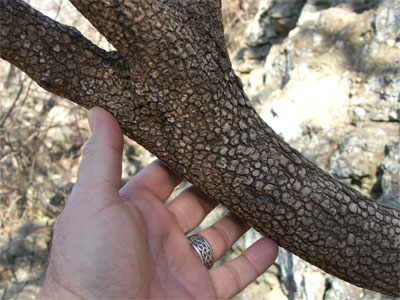
The smooth checkered trunk of rusty blackhaw. All photos by Steven Chamblee.
Rusty Blackhaw and Mineral Wells State Park
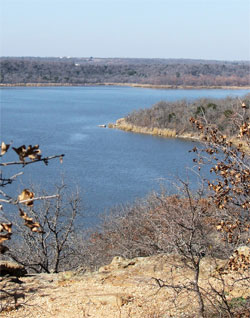
Overlooking Lake Mineral Wells from the Penitentiary Hollow trail.
Hiking down the Penitentiary Hollow trail at Mineral Wells State Park, I hear the most amazing thing. A child is complaining that “the woods here are all dead.” His dad doesn’t miss a beat, “The woods aren’t dead…they’re just sleeping. And just like people seem kind of dead when they’re asleep — they don’t talk or laugh or open their eyes — the forest can look dead when it’s asleep. But it is not dead. In the springtime, it will wake up and smile and dance.”
“That’s silly … trees don’t dance,” replies the skeptic.
“Say what you want. I’ve seen them.”
“You have not!”
“Have too … lots of times! And sometimes they sing!”
I feel kind of jealous of that kid as they amble on down the trail. That dad is coaxing his son’s imagination and molding his curiosity of nature. While respecting the scientific facts, good ol’ dad is acknowledging nature’s mysteries and magic. And this place is full of magic.
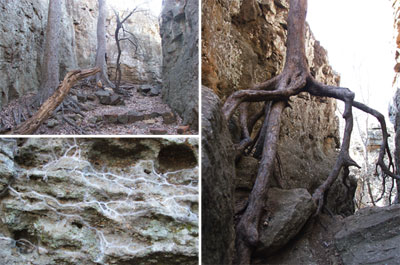
Top left photo: Trees reach for sunlight in one of the slot canyons. Bottom left photo: Strange web tunnels paint patterns on a rock wall. Right photo: Rocks have tumbled away, leaving a tree growing atop stilt roots.
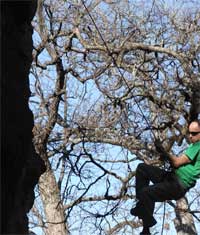
An adventurer rappels down a cliff.
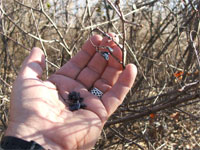
Rusty blackhaw’s edible fruits.
Sunlit stones sparkle everywhere right before your eyes … yet the glitter does not show in a photograph. Trees explode upward from the ground like frozen lightning, cutting patterns into the azure sky. Strange white lines squiggle across rock walls … a touch reveals them to be tiny web tunnels. A small tree grows in mid-air, its roots running straight across and down an invisible box. Impossible, but there it is. To my right, a human suddenly flies off a cliff and cuts through the air, only to stop inches short of crashing.
I steady myself upon a branch, and its intricate pattern draws my attention. The unique checkered bark of rusty blackhaw (Viburnum rifidulum) glides smoothly under my fingers, like some sort of cool, dry serpent. Now enlightened, I look around to find myself surrounded by dozens of these small, native Texas trees. The dense shade here under the cliffs has influenced them to grow long and thin, with few branches, and they often slither prostrate upon the ground for a few feet before rearing up to catch whatever light they can get. In a sunny location, they will grow full crowns and usually reach 15 to 20 feet tall. Spring brings baseball-sized blooms — creamy-colored inflorescences made up of dozens of small, scentless blossoms. Summer features deep green leaves so shiny that some people mistake them for plastic. Autumn yields orange and red and purple fall foliage, accented by small blue fruits that resemble and taste a bit like raisins. Sometimes these edible fruits persist into winter, hanging like little ornaments in the trees. I hold some of these tiny treasures in my hand for a moment, then fling them away to grow new wonders.
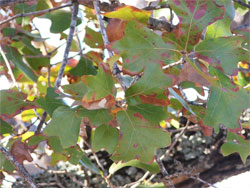
Blackjack oak with green leaves in late January.
Ahead, I see a blackjack oak tree covered with green leaves. Late January, and this deciduous tree is covered with green leaves. I look up to see some red foliage mixed into the verdant crown. Hmmm, maybe it’s part of a localized population that has somehow evolved increased cold tolerance. A quick look around and I see lots of other blackjacks, but they are all bare or have brown leaves still clinging to their twigs. What is this magical place where the impossible is ordinary?
My mind rolls back to the child and his thoughts that, “the woods here are all dead.” I chuckle to myself at how it is so universally true … we are all born blind and stay that way until we learn to open our eyes and see. Baba Dioum of Senegal, Africa, said it best: “In the end, we will conserve only what we love. We will love only what we understand. We will understand only what we are taught.”
Teach your boy well, dad.

Immersion in the natural sculpture garden.
Note from Neil: Great news! Steven Chamblee joins the Dig In TV team as our Roving Reporter as the program resumes in just a few weeks!
About the author: Steven Chamblee is the chief horticulturist for Chandor Gardens in Weatherford and a regular contributor to Neil Sperry’s GARDENS magazine and e-gardens newsletter. Steven adds these notes:
The dust is beginning to settle! We are beginning to wrap up our winter projects here at Chandor Gardens. Come and see our new entrance, the new natural gazebo, the new timber trellis, and more. Just take I-20 west to exit 409, hang a right, go 2.1 miles and hang a left on Lee Avenue. Head straight 12 blocks and you’re driving in the gates. Call 817-361-1700 for more information. You can always go to www.chandorgardens.com for a picture tour and details.
I can always use another road trip! Let me know if you’d like me to come out and speak to your group sometime. I’m low-maintenance, flexible, and you know I like to go just about anywhere. No city too big; no town to small. Just send me an e-mail at schamblee@weatherfordtx.gov and we’ll work something out.
